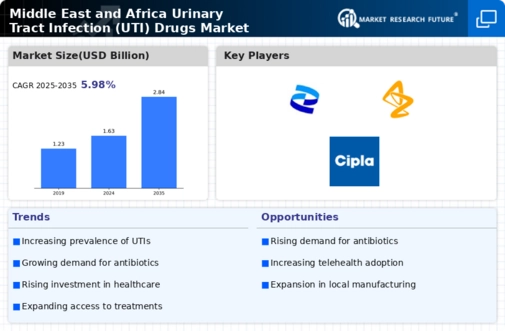Rising Incidence of UTIs
The increasing prevalence of urinary tract infections (UTIs) in the Middle East and Africa is a primary driver for the Global Middle East and Africa Urinary Tract Infection (UTI) Drugs Market Industry. Factors such as urbanization, changing lifestyles, and inadequate access to clean water contribute to this rise. In 2024, the market is projected to reach 1250 USD Million, reflecting the urgent need for effective treatment options. The growing awareness of UTI symptoms and the importance of timely medical intervention further fuels market growth. As healthcare systems evolve, the demand for innovative UTI drugs is expected to escalate, driving market dynamics.
Market Growth Projections
The Global Middle East and Africa Urinary Tract Infection (UTI) Drugs Market Industry is poised for substantial growth, with projections indicating a market value of 1250 USD Million in 2024 and an anticipated increase to 2750 USD Million by 2035. This growth trajectory suggests a compound annual growth rate (CAGR) of 7.43% from 2025 to 2035. Factors contributing to this growth include rising UTI incidences, advancements in drug development, and increasing healthcare expenditures. The market dynamics indicate a robust future for UTI drug manufacturers, with opportunities for innovation and expansion in treatment options.
Growing Awareness and Education
The rising awareness and education regarding urinary tract infections are pivotal for the Global Middle East and Africa Urinary Tract Infection (UTI) Drugs Market Industry. Public health campaigns and educational initiatives aimed at informing the population about UTI symptoms, prevention, and treatment options are gaining traction. This increased awareness is likely to lead to higher diagnosis rates and subsequent demand for UTI medications. As more individuals seek medical help, the market is expected to grow, with a projected value of 1250 USD Million in 2024. Enhanced understanding of UTIs could potentially reduce the stigma associated with these infections, further driving market growth.
Increasing Healthcare Expenditure
Rising healthcare expenditure across the Middle East and Africa is a crucial driver for the Global Middle East and Africa Urinary Tract Infection (UTI) Drugs Market Industry. Governments and private sectors are investing in healthcare infrastructure, leading to improved access to medical services and treatments. This increased spending is likely to enhance the availability of UTI drugs, thereby addressing the growing demand for effective therapies. As healthcare budgets expand, the market is anticipated to witness a compound annual growth rate (CAGR) of 7.43% from 2025 to 2035. This trend suggests a robust future for UTI drug manufacturers in the region.
Regulatory Support for Drug Approvals
Regulatory bodies in the Middle East and Africa are increasingly supportive of the approval processes for new UTI drugs, which is a significant driver for the Global Middle East and Africa Urinary Tract Infection (UTI) Drugs Market Industry. Streamlined regulatory frameworks and expedited approval pathways are encouraging pharmaceutical companies to invest in UTI drug development. This supportive environment is likely to result in the introduction of innovative therapies that address unmet medical needs. As a consequence, the market is projected to grow substantially, with expectations of reaching 2750 USD Million by 2035. The proactive stance of regulatory agencies may enhance the overall competitiveness of the market.
Advancements in Pharmaceutical Research
Innovations in pharmaceutical research and development are significantly impacting the Global Middle East and Africa Urinary Tract Infection (UTI) Drugs Market Industry. The introduction of novel antibiotics and alternative therapies is enhancing treatment efficacy and patient outcomes. Research institutions and pharmaceutical companies are increasingly focusing on developing targeted therapies that address antibiotic resistance, a growing concern in the region. This trend is likely to contribute to market expansion, with projections indicating a market value of 2750 USD Million by 2035. Enhanced collaboration between academia and industry is expected to accelerate the pace of drug development, further stimulating market growth.














Leave a Comment